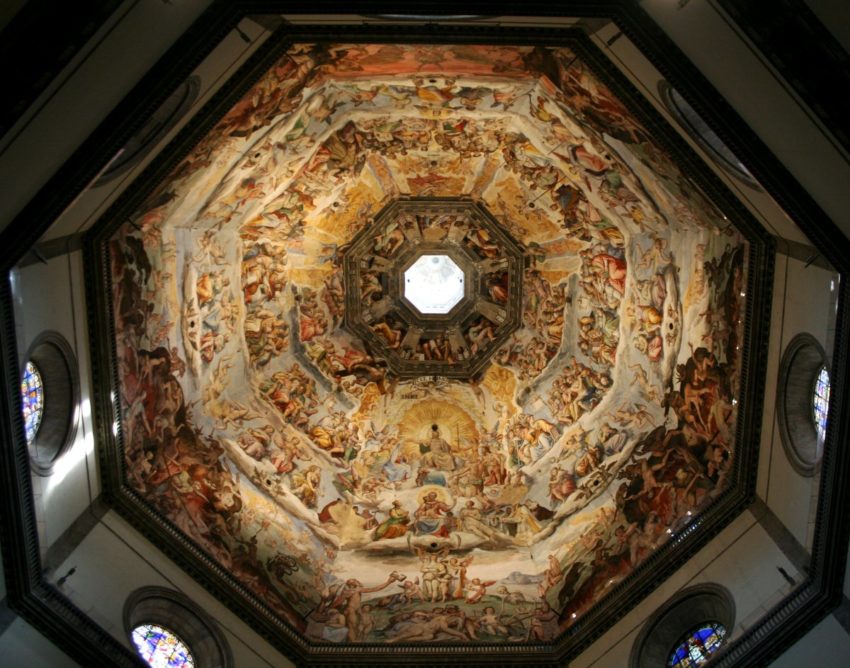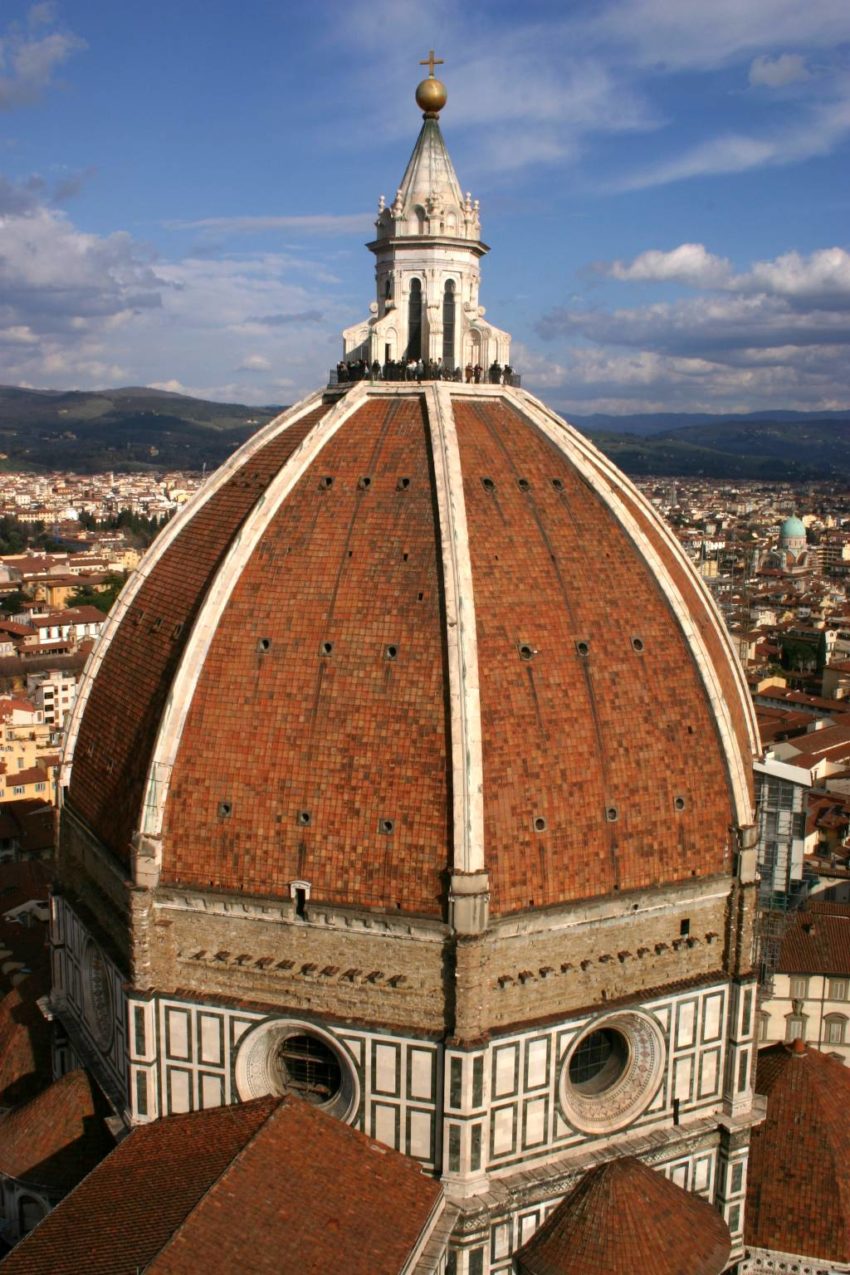[box type=”shadow”]In Florence, Italy, the Duomo — Basilica di Santa Maria del Fiore — is the main church, and, thanks to its great dome, the structure is visible from throughout the city.
But it wasn’t always that way. In fact, for more than 100 years (including four decades after the nave was finished), one portion of the building had no roof, and rainwater would freely fall into the church.
Part of the delay stemmed from the problem of how to build the dome everyone wanted.
In 1418, a competition was announced to come up with the best design. The excerpt below tells the story of how the exceptionally persistent, incredibly confident and remarkably talented architect and sculptor Filippo Brunelleschi used his smarts to ultimately win the contract.[/box]

As told by artist & historian Giorgio Vasari, c1550
By the year 1420, all these ultramontane masters were finally assembled in Florence, and likewise those of Tuscany and all the ingenious craftsmen of design in Florence; and so Filippo [Brunelleschi] returned from Rome. They all assembled, therefore, in the Office of Works of S. Maria del Fiore, in the presence of the Consuls and of the Wardens, together with a select body of the most ingenious citizens, to the end that these might hear the mind of each master on the question and might decide on a method of vaulting this tribune.
Having called them, then, into the audience, they heard the minds of all, one by one, and the plan that each architect had devised for that work. And a fine thing it was to hear their strange and diverse opinions about the matter… Filippo alone said that it could be raised without so much woodwork, without piers, without earth, without so great expenditure on so many arches, and very easily without any framework.
It appeared to the Consuls, who were expecting to hear of some beautiful method, and to the Wardens of Works and to all those citizens, that Filippo had talked like a fool; and deriding him with mocking laughter, they turned away, bidding him talk of something else, seeing that this was the plan of a madman, as he was.
Whereupon Filippo, feeling himself affronted, answered: “My Lords, rest assured that it is not possible to raise the cupola in any other manner than this; and although you laugh at me, you will recognize, unless you mean to be obstinate, that it neither must nor can be done in any other way. And it is necessary, if you wish to erect it in the way that I have thought of, that it should be turned with the curve of a quarter-acute arch, and made double, one vault within, and the other without, in such wise that a man may be able to walk between the one and the other.
“And over the corners of the angles of the eight sides the fabric must be bound together through its thickness by dove-tailing the stones, and its sides, likewise, must be girt round with oaken ties. And it is necessary to think of the lights, the staircases, and the conduits whereby the rain-water may be able to run off; and not one of you has remembered that you must provide for the raising of scaffoldings within, when the mosaics come to be made, together with an infinite number of difficulties. But I, who see the vaulting raised, know that there is no other method and no other way of raising it than this that I am describing.”
And growing heated as he spoke, the more he sought to expound his conception, to the end that they might understand it and believe in it, the greater grew their doubts about his proposal, so that they believed in him less and less, and held him to be an ass and a babbler.

Whereupon, having been dismissed several times and finally refusing to go, he was carried away bodily from the audience by their servants, being thought to be wholly mad; and this affront was the reason that Filippo could afterwards say that he did not dare to pass through any part of the city, for fear lest someone might say: “There goes that madman.”
The Consuls remained in the Audience Chamber all confused, both by the difficult methods of the original masters and by this last method of Filippo’s, which they thought absurd, for it appeared to them that he would ruin the work in two ways: first, by making the vaulting double, which would have made it enormous and unwieldy in weight; and secondly, by making it without a framework.
On the other hand, Filippo, who had spent so many years in study in order to obtain the commission, knew not what to do and was often tempted to leave Florence.
However, wishing to prevail, he was forced to arm himself with patience, having insight enough to know that the brains of the men of that city did not abide very firmly by any one resolution. Filippo could have shown a little model that he had in his possession, but he did not wish to show it, having recognized the small intelligence of the Consuls, the envy of the craftsmen, and the instability of the citizens, who favored now one and now another, according as it pleased each man best; and I do not marvel at this, since every man in that city professes to know as much in these matters as the experienced masters know, although those who truly understand them are but few; and let this be said without offense to those who have the knowledge.
What Filippo, therefore, had not been able to achieve before the tribunal, he began to effect with individuals, talking now to a Consul, now to a Warden, and likewise to many citizens; and showing them part of his design, he induced them to determine to allot this work either to him or to one of the foreigners.
Wherefore the Consuls, the Wardens of Works, and those citizens, regaining courage, assembled together, and the architects disputed concerning this matter, but all were overcome and conquered by Filippo with many arguments; and here, so it is said, there arose the dispute about the egg, in the following manner.
They would have liked Filippo to speak his mind in detail, and to show his model, as they had shown theirs; but this he refused to do, proposing instead to those masters, both the foreign and the native, that whosoever could make an egg stand upright on a flat piece of marble should build the cupola, since thus each man’s intellect would be discerned. Taking an egg, therefore, all those masters sought to make it stand upright, but not one could find the way.
Whereupon Filippo, being told to make it stand, took it graciously, and, giving one end of it a blow on the flat piece of marble, made it stand upright.
The craftsmen protested that they could have done the same; but Filippo answered, laughing, that they could also have raised the cupola, if they had seen the model or the design.
And so it was resolved that he should be commissioned to carry out this work…
[box type=”shadow”]Construction began in 1420, and was completed in 1436. The Duomo had the first octagonal built without a temporary wooden supporting frame, and is considered a renaissance masterpiece.[/box]
This text is from “Lives of the Most Eminent Painters Sculptors and Architects, Vol 2,” by Giorgio Vasari, c1550 (translated by Gaston du C de Vere, 1912)







